Projected Changes of Day-to-Day Precipitation and Choco Low-Level Jet Relationships over the Far Eastern Tropical Pacific and Western Colombia from Two CMIP6 GCM Models
Abstract
1. Introduction
2. Materials and Methods
2.1. CMIP6 Models
2.2. Daily Gridded Observations
2.3. ChocoJet Index
2.4. Correlation Patterns and Future Climate Projections
2.5. Characterizing ENSO
3. Results
3.1. Rainfall Maximum and Low-Level Flow
3.2. Precipitation-ChocoJet Correlation Patterns
3.3. Sea Surface Temperature and ENSO
4. Discussion
5. Conclusions
Author Contributions
Funding
Institutional Review Board Statement
Informed Consent Statement
Data Availability Statement
Acknowledgments
Conflicts of Interest
References
- Poveda, G.; Mesa, O.J. On the Existence of Lloró (the Rainiest Locality on Earth): Enhanced Ocean-Land-Atmosphere Interaction by a Low-Level Jet. Geophys. Res. Lett. 2000, 27, 1675–1678. [Google Scholar] [CrossRef]
- Mejía, J.F.; Yepes, J.; Henao, J.J. Towards a Mechanistic Understanding of Precipitation Over the Far Eastern Tropical Pacific and Western Colombia, One of the Rainiest Spots on Earth. J. Geophys. Res. Atmos. 2021, 126, e2020JD033415. [Google Scholar] [CrossRef]
- Liu, N.; Liu, C.; Chen, B.; Zipser, E. What Are the Favorable Large-Scale Environments for the Highest-Flash-Rate Thunderstorms on Earth? J. Atmos. Sci. 2020, 77, 1583–1612. [Google Scholar] [CrossRef]
- Whitaker, J.W.; Maloney, E.D. Genesis of an east pacific easterly wave from a Panama bight MCS: A case study analysis from June 2012. J. Atmos. Sci. 2020, 77, 3567–3584. [Google Scholar] [CrossRef]
- Jaramillo, D.; Vélez, M.I.; Escobar, J. Mid to late holocene dry events in Colombia’s super humid Western Cordillera reveal changes in regional atmospheric circulation. Quat. Sci. Rev. 2021, 261, 106937. [Google Scholar] [CrossRef]
- Sarachik, E.S.; Cane, M.A. The El Niño-Southern Oscillation Phenomenon; Cambridge University Press: New York, NY, USA, 2010; ISBN 9780521847865. [Google Scholar]
- Cai, W.; McPhaden, M.J.; Grimm, A.M. Climate impacts of the El Niño–Southern Oscillation on South America. Nat. Rev. Earth Environ. 2020, 1, 215–231. [Google Scholar] [CrossRef]
- Salas, H.D.; Poveda, G.; Mesa, Ó.J.; Marwan, N. Generalized Synchronization Between ENSO and Hydrological Variables in Colombia: A Recurrence Quantification Approach. Front. Appl. Math. Stat. 2020, 6, 3. [Google Scholar] [CrossRef]
- Grimm, A.M.; Tedeschi, R.G. ENSO and extreme rainfall events in South America. J. Clim. 2009, 22, 1589–1609. [Google Scholar] [CrossRef]
- Poveda, G.; Vélez, J.I.; Mesa, O.; Hoyos, C.; Mejía, J.; Barco, O.J.; Correa, P.L. Influencia de fenómenos macroclimáticos sobre el ciclo anual de la hidrología Colombiana: Cuantificación lineal, no lineal y percentiles probabilísticos. Meteorol. Colomb. 2002, 6, 121–130. [Google Scholar]
- Cerón, W.L.; Kayano, M.T.; Andreoli, R.V.; Canchala, T.; Carvajal-Escobar, Y.; Alfonso-Morales, W. Rainfall Variability in Southwestern Colombia: Changes in ENSO-Related Features. Pure Appl. Geophys. 2021, 178, 1087–1103. [Google Scholar] [CrossRef]
- Poveda, G. La hidroclimatología de Colombia: Una síntesis desde la escala inter-decadal hasta la escala diurna. Acad. Colomb. Cienc 2004, 28, 201–222. [Google Scholar]
- Tian, B.; Dong, X. The Double-ITCZ Bias in CMIP3, CMIP5, and CMIP6 Models Based on Annual Mean Precipitation. Geophys. Res. Lett. 2020, 47, e2020GL087232. [Google Scholar] [CrossRef]
- Arias, P.A.; Martínez, J.A.; Vieira, S.C. Moisture sources to the 2010–2012 anomalous wet season in northern South America. Clim. Dyn. 2015, 45, 2861–2884. [Google Scholar] [CrossRef]
- Wang, C. Variability of the Caribbean Low-Level Jet and its relations to climate. Clim. Dyn. 2007, 29, 411–422. [Google Scholar] [CrossRef]
- Sakamoto, M.; Ambrizzi, T.; Poveda, G. Moisture Sources and Life Cycle of Convective Systems over Western Colombia. Adv. Meteorol. 2011, 2011, 890759. [Google Scholar] [CrossRef]
- Serna, L.M.; Arias, P.A.; Vieira, S.C. Las corrientes superficiales de chorro del Chocó y el Caribe durante los eventos de El Niño y El Niño Modoki. Rev. Acad. Colomb. Cienc. Exactas Físicas Nat. 2018, 42, 410–421. [Google Scholar] [CrossRef]
- Hoyos, I.; Dominguez, F.; Cañón-Barriga, J.; Martínez, J.A.; Nieto, R.; Gimeno, L.; Dirmeyer, P.A. Moisture origin and transport processes in Colombia, northern South America. Clim. Dyn. 2017, 50, 971–990. [Google Scholar] [CrossRef]
- Morales, J.S.; Arias, P.A.; Martínez, J.A.; Durán-Quesada, A.M. The role of low-level circulation on water vapour transport to central and northern South America: Insights from a 2D Lagrangian approach. Int. J. Clim. 2021, 41, E2662–E2682. [Google Scholar] [CrossRef]
- Sierra, J.P.; Arias, P.A.; Vieira, S.C.; Agudelo, J. How well do CMIP5 models simulate the low-level jet in western Colombia? Clim. Dyn. 2017, 51, 2247–2265. [Google Scholar] [CrossRef]
- Marengo, J.A.; Ambrizzi, T.; da Rocha, R.P.; Alves, L.M.; Cuadra, S.V.; Valverde, M.C.; Torres, R.R.; Santos, D.C.; Ferraz, S.E.T. Future change of climate in South America in the late twenty-first century: Intercomparison of scenarios from three regional climate models. Clim. Dyn. 2010, 35, 1073–1097. [Google Scholar] [CrossRef]
- Steinhoff, D.F.; Monaghan, A.J.; Clark, M.P. Projected impact of twenty-first century ENSO changes on rainfall over Central America and northwest South America from CMIP5 AOGCMs. Clim. Dyn. 2015, 44, 1329–1349. [Google Scholar] [CrossRef]
- Arias, P.A.; Ortega, G.; Villegas, L.D.; Martínez, J.A. Colombian climatology in CMIP5/CMIP6 models: Persistent biases and improvements. Rev. Fac. Ing. 2021, 100, 75–96. [Google Scholar] [CrossRef]
- Sierra, J.P.; Arias, P.A.; Vieira, S.C. Precipitation over Northern South America and its seasonal variability as simulated by the CMIP5 models. Adv. Meteorol. 2014, 2015, 634720. [Google Scholar] [CrossRef]
- Yin, L.; Fu, R.; Shevliakova, E.; Dickinson, R.E. How well can CMIP5 simulate precipitation and its controlling processes over tropical South America? Clim. Dyn. 2012, 41, 3127–3143. [Google Scholar] [CrossRef]
- Almazroui, M.; Islam, M.N.; Saeed, F.; Saeed, S.; Ismail, M.; Ehsan, M.A.; Diallo, I.; O’Brien, E.; Ashfaq, M.; Martínez-Castro, D.; et al. Projected Changes in Temperature and Precipitation Over the United States, Central America, and the Caribbean in CMIP6 GCMs. Earth Syst. Environ. 2021, 5, 1–24. [Google Scholar] [CrossRef]
- Cerón, W.L.; Andreoli, R.V.; Kayano, M.T.; de Souza, R.A.F.; Jones, C.; Carvalho, L.M.V. The influence of the Atlantic multidecadal oscillation on the Choco low-level jet and precipitation in Colombia. Atmosphere 2020, 11, 174. [Google Scholar] [CrossRef]
- Yepes, J.; Poveda, G.; Mejía, J.F. Choco-JEX: A research experiment focused on the Chocó low-level jet over the far eastern Pacific and western Colombia. Bull. Am. Meteorol. Soc. 2019, 100, 779–796. [Google Scholar] [CrossRef]
- Jaramillo, L.; Poveda, G.; Mejía, J.F. Mesoscale convective systems and other precipitation features over the tropical Americas and surrounding seas as seen by TRMM. Int. J. Clim. 2017, 37, 380–397. [Google Scholar] [CrossRef]
- Moncrieff, M.W. Toward a Dynamical Foundation for Organized Convection Parameterization in GCMs. Geophys. Res. Lett. 2019, 46, 14103–14108. [Google Scholar] [CrossRef]
- Pabón-Caicedo, J.D.; Arias, P.A.; Carril, A.F.; Espinoza, J.C.; Borrell, L.F.; Goubanova, K.; Lavado-Casimiro, W.; Masiokas, M.; Solman, S.; Villalba, R. Observed and Projected Hydroclimate Changes in the Andes. Front. Earth Sci. 2020, 8, 1–29. [Google Scholar] [CrossRef]
- Sierra, J.P.; Arias, P.A.; Durán-Quesada, A.M.; Tapias, K.A.; Vieira, S.C.; Martínez, J.A. The Choco low-level jet: Past, present and future. Clim. Dyn. 2021, 56, 2667–2692. [Google Scholar] [CrossRef]
- Eyring, V.; Bony, S.; Meehl, G.A.; Senior, C.A.; Stevens, B.; Stouffer, R.J.; Taylor, K.E. Overview of the Coupled Model Intercomparison Project Phase 6 (CMIP6) experimental design and organization. Geosci. Model Dev. 2016, 9, 1937–1958. [Google Scholar] [CrossRef]
- Gettelman, A.; Hannay, C.; Bacmeister, J.T.; Neale, R.B.; Pendergrass, A.G.; Danabasoglu, G.; Lamarque, J.; Fasullo, J.T.; Bailey, D.A.; Lawrence, D.M.; et al. High climate sensitivity in the Community Earth System Model Version 2 (CESM2). Geophys. Res. Lett. 2019, 46, 8329–8337. [Google Scholar] [CrossRef]
- Müller, W.A.; Jungclaus, J.H.; Mauritsen, T.; Baehr, J.; Bittner, M.; Budich, R.; Bunzel, F.; Esch, M.; Ghosh, R.; Haak, H.; et al. A higher-resolution version of the Max Planck Institute Earth System Model (MPI-ESM1.2-HR). J. Adv. Model. Earth Syst. 2018, 10, 1383–1413. [Google Scholar] [CrossRef]
- Riahi, K.; Van Vuuren, D.P.; Kriegler, E.; Edmonds, J.; O’Neill, B.C.; Fujimori, S.; Bauer, N.; Calvin, K.; Dellink, R.; Fricko, O.; et al. The Shared Socioeconomic Pathways and their energy, land use, and greenhouse gas emissions implications: An overview. Glob. Environ. Chang. 2016, 42, 153–168. [Google Scholar] [CrossRef]
- Mcbride, L.A.; Hope, A.P.; Canty, T.P.; Bennett, B.F.; Tribett, W.R.; Salawitch, R.J. Comparison of CMIP6 historical climate simulations and future projected warming to an empirical model of global climate. Earth Syst. Dyn. 2021, 12, 545–579. [Google Scholar] [CrossRef]
- Dominguez, F.; Cañon, J.; Valdes, J. IPCC-AR4 climate simulations for the Southwestern US: The importance of future ENSO projections. Clim. Chang. 2010, 99, 499–514. [Google Scholar] [CrossRef]
- Huffman, G.J.; Stocker, E.F.; Bolvin, D.T.; Nelkin, E.J.; Tan, J. GPM IMERG Final Precipitation L3 1 Day 0.1 Degree × 0.1 Degree V06; Savtchenko, A., Ed.; Goddard Earth Sciences Data and Information Services Center (GES DISC): Greenbelt, MD, USA, 2020. Available online: https://disc.gsfc.nasa.gov/datasets/GPM_3IMERGDF_06/summary (accessed on 1 October 2020).
- Schröder, M.; Becker, A.; Dietzsch, F.; Fennig, K.; Graw, K.; Gutenstein, M.; Hollmann, R.; Niedorf, A.; Ziese, M. HOAPS/GPCC Global Daily Precipitation Data Record with Uncertainty Estimates Using Satellite and Gauge Based Observations at 1.0°. 2019. Available online: https://gpcc.dwd.de (accessed on 1 October 2020).
- Hersbach, H.; Bell, B.; Berrisford, P.; Biavati, G.; Horányi, A.; Muñoz Sabater, J.; Rozum, I. ERA5 Hourly Data on Pressure Levels from 1979 to Present. Copernicus Climate Change Service (C3S) Climate Data Store (CDS). 2020. Available online: https://cds.climate.copernicus.eu/cdsapp#!/dataset/10.24381/cds.bd0915c6?tab=overview (accessed on 3 March 2021).
- Pearson, K. Note on regression and inheritance in the case of two parents. Proc. R. Soc. Lond. 1895, 58, 240–242. [Google Scholar]
- Krinner, G.; Kharin, V.; Roehrig, R.; Scinocca, J.; Codron, F. Historically-based run-time bias corrections substantially improve model projections of 100 years of future climate change. Commun. Earth Environ. 2020, 1, 29. [Google Scholar] [CrossRef]
- Montealegre, J.E. Modelo Institucional del IDEAM Sobre el Efecto Climático de los Fenómenos El Niño y La Niña en Colombia; IDEAM: Bogotá, Colombia, 2007; p. 81. Available online: http://www.ideam.gov.co (accessed on 1 October 2020).
- Gallego, D.; García-Herrera, R.; Gómez-Delgado, F.d.P.; Ordoñez-Perez, P.; Ribera, P. Tracking the Choco jet since the 19th Century by using historical wind direction measurements. Earth Syst. Dyn. Discuss. 2018, 1–23. [Google Scholar] [CrossRef]
- Bedoya-Soto, J.M.; Aristizábal, E.; Carmona, A.M.; Poveda, G. Seasonal shift of the diurnal cycle of rainfall over Medellin’s valley, Central Andes of Colombia (1998–2005). Front. Earth Sci. 2019, 7, 92. [Google Scholar] [CrossRef]
- Large, W.G.; Danabasoglu, G. Attribution and impacts of upper-ocean biases in CCSM3. J. Clim. 2006, 19, 2325–2346. [Google Scholar] [CrossRef]
- Li, G.; Xie, S.P. Origins of tropical-wide SST biases in CMIP multi-model ensembles. Geophys. Res. Lett. 2012, 39, 1–5. [Google Scholar] [CrossRef]
- Mejia, J.F.; Koračin, D.; Wilcox, E.M. Effect of coupled global climate models sea surface temperature biases on simulated climate of the western United States. Int. J. Clim. 2018, 38, 5386–5404. [Google Scholar] [CrossRef]
- Dong, L.; Leung, L.R.; Song, F.; Lu, J. Uncertainty in El Niño-like warming and California precipitation changes linked by the Interdecadal Pacific Oscillation. Nat. Commun. 2021, 12, 6484. [Google Scholar] [CrossRef]
- Flores-Aqueveque, V.; Rojas, M.; Aguirre, C.; Arias, P.A.; González, C. South Pacific Subtropical High from the late Holocene to the end of the 21st century: Insights from climate proxies and general circulation models. Clim. Past 2020, 16, 79–99. [Google Scholar] [CrossRef]
- Rauscher, S.A.; Giorgi, F.; Diffenbaugh, N.S.; Seth, A. Extension and Intensification of the Meso-American mid-summer drought in the twenty-first century. Clim. Dyn. 2008, 31, 551–571. [Google Scholar] [CrossRef]
- Hwang, Y.-T.; Frierson, D.M.W.; Kang, S.M. Anthropogenic sulfate aerosol and the southward shift of tropical precipitation in the late 20th century. Geophys. Res. Lett. 2013, 40, 2845–2850. [Google Scholar] [CrossRef]
- Mamalakis, A.; Randerson, J.T.; Yu, J.-Y.; Pritchard, M.S.; Magnusdottir, G.; Smyth, P.; Levine, P.A.; Yu, S.; Foufoula-Georgiou, E. Zonally contrasting shifts of the tropical rain belt in response to climate change. Nat. Clim. Chang. 2021, 11, 143–151. [Google Scholar] [CrossRef]
- Murphy, M.J.; Georgakakos, K.P.; Shamir, E. Climatological analysis of December rainfall in the Panama Canal Watershed. Int. J. Clim. 2014, 34, 403–415. [Google Scholar] [CrossRef]
- Poveda, G.; Mesa, O.J. Feedbacks between hydrological processes in tropical South America and large-scale ocean–atmospheric phenomena. J. Clim. 1997, 10, 2690–2702. [Google Scholar] [CrossRef]
- Ministerio de Ambiente, Vivienda y Desarrollo Territorial. Atlas Climatológico de Colombia; Instituto de Hidrología, Meteorología y Estudios Ambientales (IDEAM 2005): Bogotá, Colombia, 2007; Volume 18. Available online: http://www.ideam.gov.co (accessed on 1 October 2020).
- Eslava, R.J.A. Climatología y diversidad climática de Colombia. Rev. Acad. Colomb. Cienc. 1993, 18, 507–539. [Google Scholar]
- Samanta, D.; Karnauskas, K.B.; Goodkin, N.F. Tropical Pacific SST and ITCZ biases in climate models: Double trouble for future rainfall projections? Geophys. Res. Lett. 2019, 46, 2242–2252. [Google Scholar] [CrossRef]
- Maloney, E.D.; Gettelman, A.; Ming, Y.; Neelin, J.D.; Barrie, D.; Mariotti, A.; Chen, C.-C.; Coleman, D.R.B.; Kuo, Y.; Singh, B.; et al. Process-Oriented Evaluation of Climate and Weather Forecasting Models. Bull. Am. Meteorol. Soc. 2019, 100, 1665–1686. [Google Scholar] [CrossRef]
- Warner, T.T.; Mapes, B.E.; Xu, M. Diurnal patterns of rainfall in northwestern South America. Part II: Model simulations. Mon. Weather Rev. 2003, 131, 813–829. [Google Scholar] [CrossRef]
- Posada-Marín, J.A.; Rendón, A.M.; Salazar, J.F.; Mejía, J.F.; Villegas, J.C. WRF downscaling improves ERA-Interim representation of precipitation around a tropical Andean valley during El Niño: Implications for GCM-scale simulation of precipitation over complex terrain. Clim. Dyn. 2019, 52, 3609–3629. [Google Scholar] [CrossRef]
- Mapes, B.E.; Warner, T.T.; Negri, A.J. Diurnal patterns of rainfall in northwestern South America. Part I: Observations and Context. Mon. Weather Rev. 2003, 131, 799–812. [Google Scholar] [CrossRef]
- Yepes, J.; Mejía, J.F.; Mapes, B.; Poveda, G. Gravity waves and other mechanisms modulating the diurnal precipitation over one of the rainiest spots on Earth: Observations and Simulations in 2016. Mon. Weather Rev. 2020, 148, 3933–3950. [Google Scholar] [CrossRef]
- Valencia, J.; Yepes; Mejía, J.F.; Builes-Jaramillo, A.; Salas, H.D. Influence of Tropical Easterly Waves on ChocoJet during the 2019 OTREC campaign. J. Hydromet. 2022; in preparation. [Google Scholar]
- Raymond, D.J.; Fuchs-Stone, Ž. Emergent properties of convection in OTREC and PREDICT. J. Geophys. Res. Atmos. 2021, 126, e2020JD033585. [Google Scholar] [CrossRef]
- Rydbeck, A.V.; Maloney, E.D.; Alaka, G.J., Jr. In situ initiation of east pacific easterly waves in a regional model. J. Atmos. Sci. 2017, 74, 333–351. [Google Scholar] [CrossRef]
- Poveda, G.; Álvarez, D.M.; Rueda, Ó.A. Hydro-climatic variability over the Andes of Colombia associated with ENSO: A review of climatic processes and their impact on one of the Earth’s most important biodiversity hotspots. Clim. Dyn. 2011, 36, 2233–2249. [Google Scholar] [CrossRef]
- Gallego, D.; García-Herrera, R.; Gómez-Delgado, F.D.P.; Ordoñez-Perez, P.; Ribera, P. Tracking the moisture transport from the Pacific towards Central and northern South America since the late 19th century. Earth Syst. Dyn. 2019, 10, 319–331. [Google Scholar] [CrossRef]
- Hoyos, I.; Cañón-Barriga, J.; Arenas-Suárez, T.; Dominguez, F.; Rodríguez, B.A. Variability of regional atmospheric moisture over Northern South America: Patterns and underlying phenomena. Clim. Dyn. 2019, 52, 893–911. [Google Scholar] [CrossRef]
- Bischoff, T.; Schneider, T. The Equatorial Energy Balance, ITCZ Position, and Double-ITCZ Bifurcations. J. Clim. 2016, 29, 2997–3013. [Google Scholar] [CrossRef]
- Ma, J.; Xu, S.; Wang, B. Warm bias of sea surface temperature in Eastern boundary current regions—A study of effects of horizontal resolution in CESM. Ocean Dyn. 2019, 69, 939–954. [Google Scholar] [CrossRef]
- Zuluaga, M.D.; Houze, R.A. Extreme convection of the near-equatorial Americas, Africa, and adjoining oceans as seen by TRMM. Mon. Weather Rev. 2015, 143, 298–316. [Google Scholar] [CrossRef]
- Giraldo-Cardenas, S.; Arias, P.A.; Vieira, S.C.; Zuluaga, M.D. Easterly waves and precipitation over northern South America and the Caribbean. Int. J. Clim. 2021, 42, 1483–1499. [Google Scholar] [CrossRef]
- Chen, G.; Ling, J.; Zhang, R.; Xiao, Z.; Li, C. The MJO from CMIP5 to CMIP6: Perspectives from tracking MJO precipitation. Geophys. Res. Lett. 2022, 49, e2021GL095241. [Google Scholar] [CrossRef]
- Le, P.V.V.; Guilloteau, C.; Mamalakis, A.; Foufoula-Georgiou, E. Underestimated MJO variability in CMIP6 models. Geophys. Res. Lett. 2021, 48, e2020GL092244. [Google Scholar] [CrossRef]
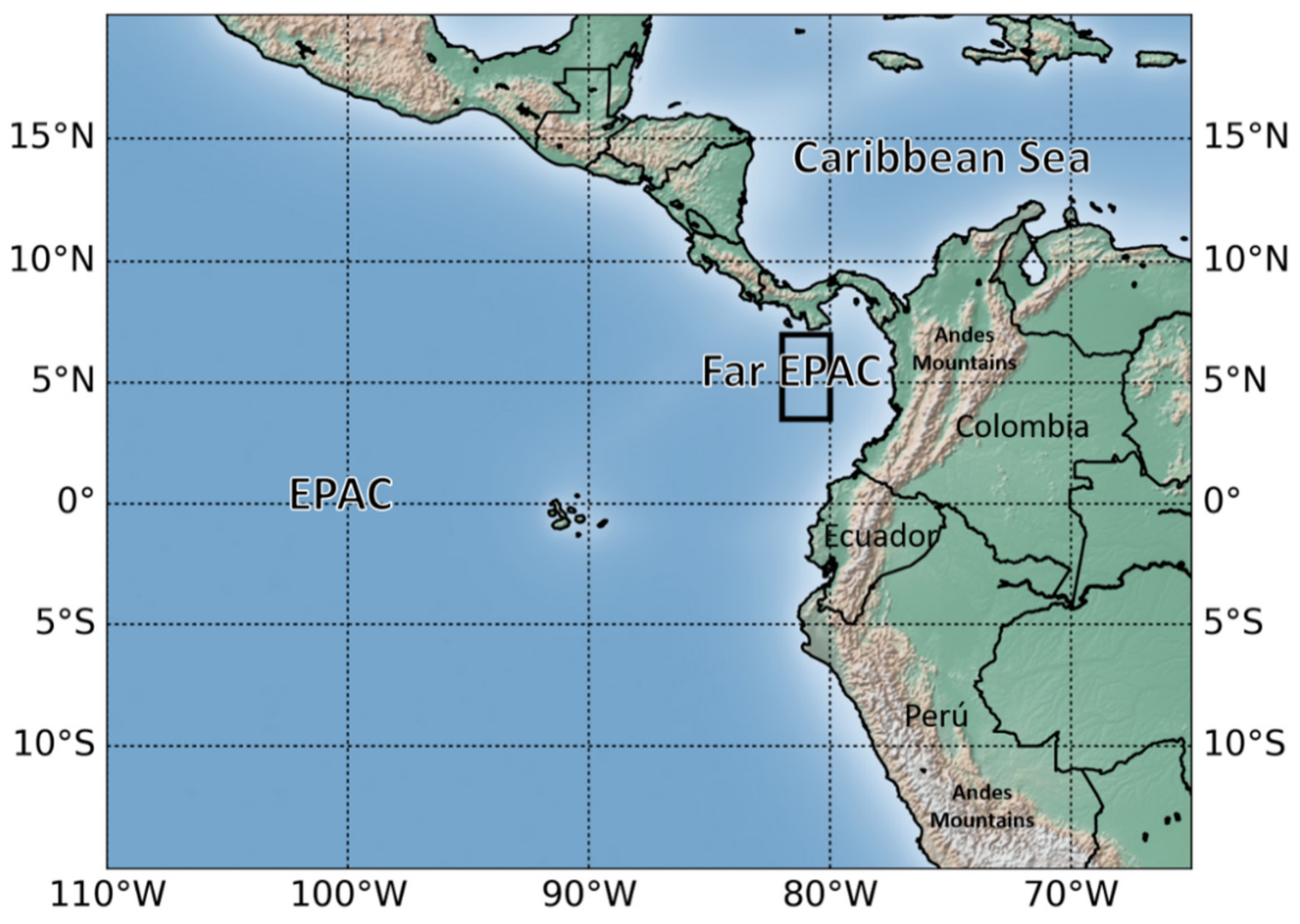

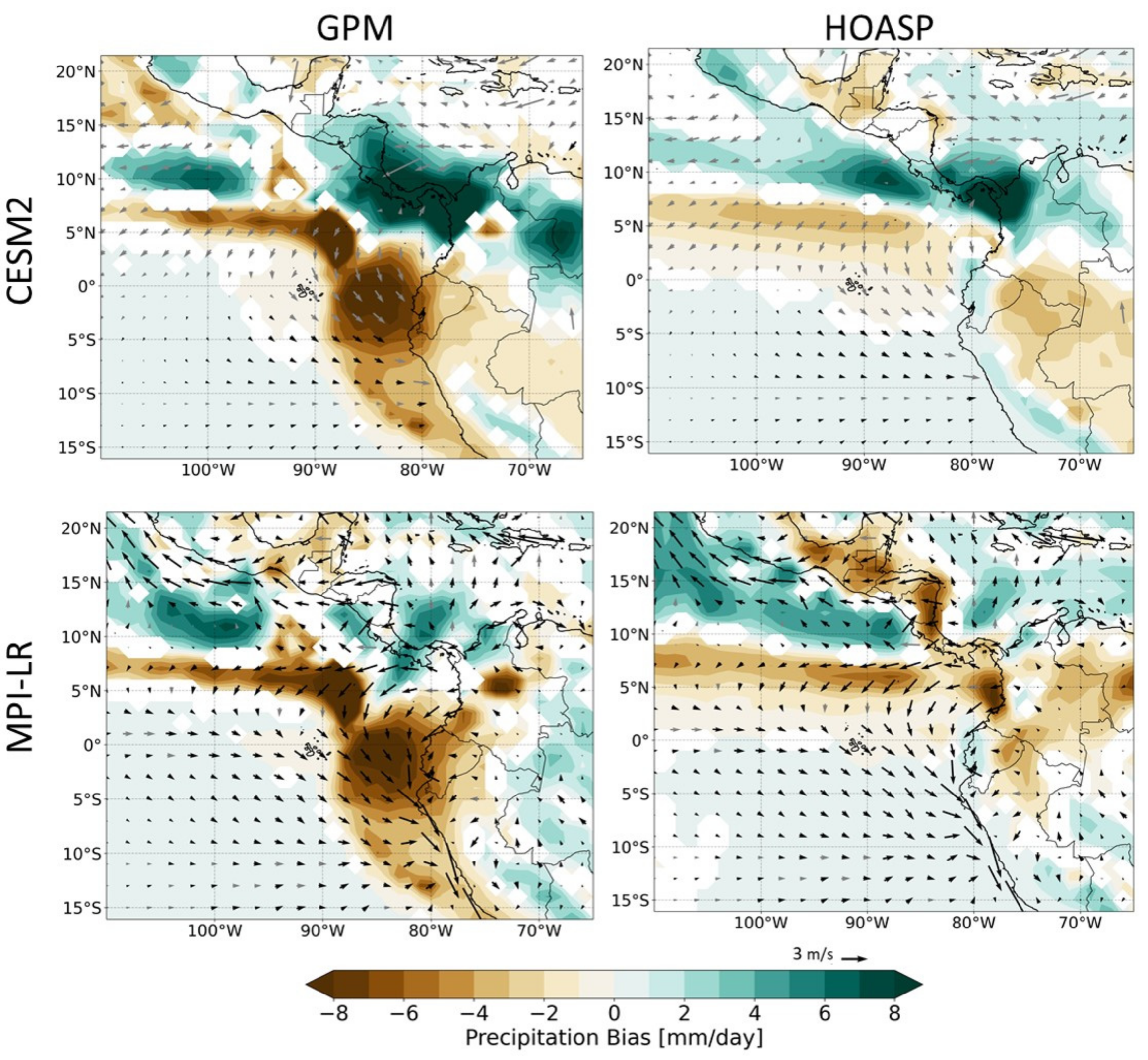
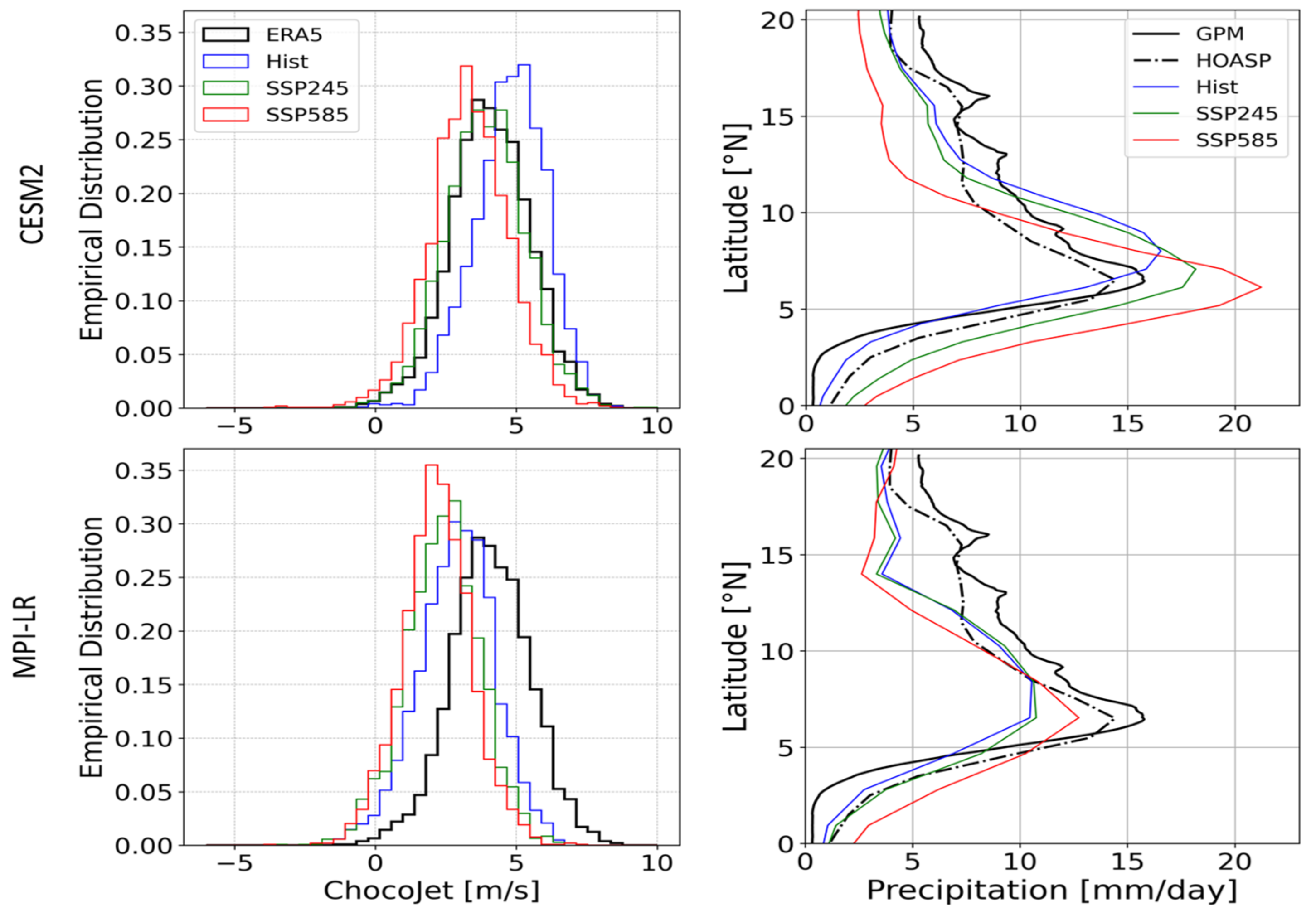



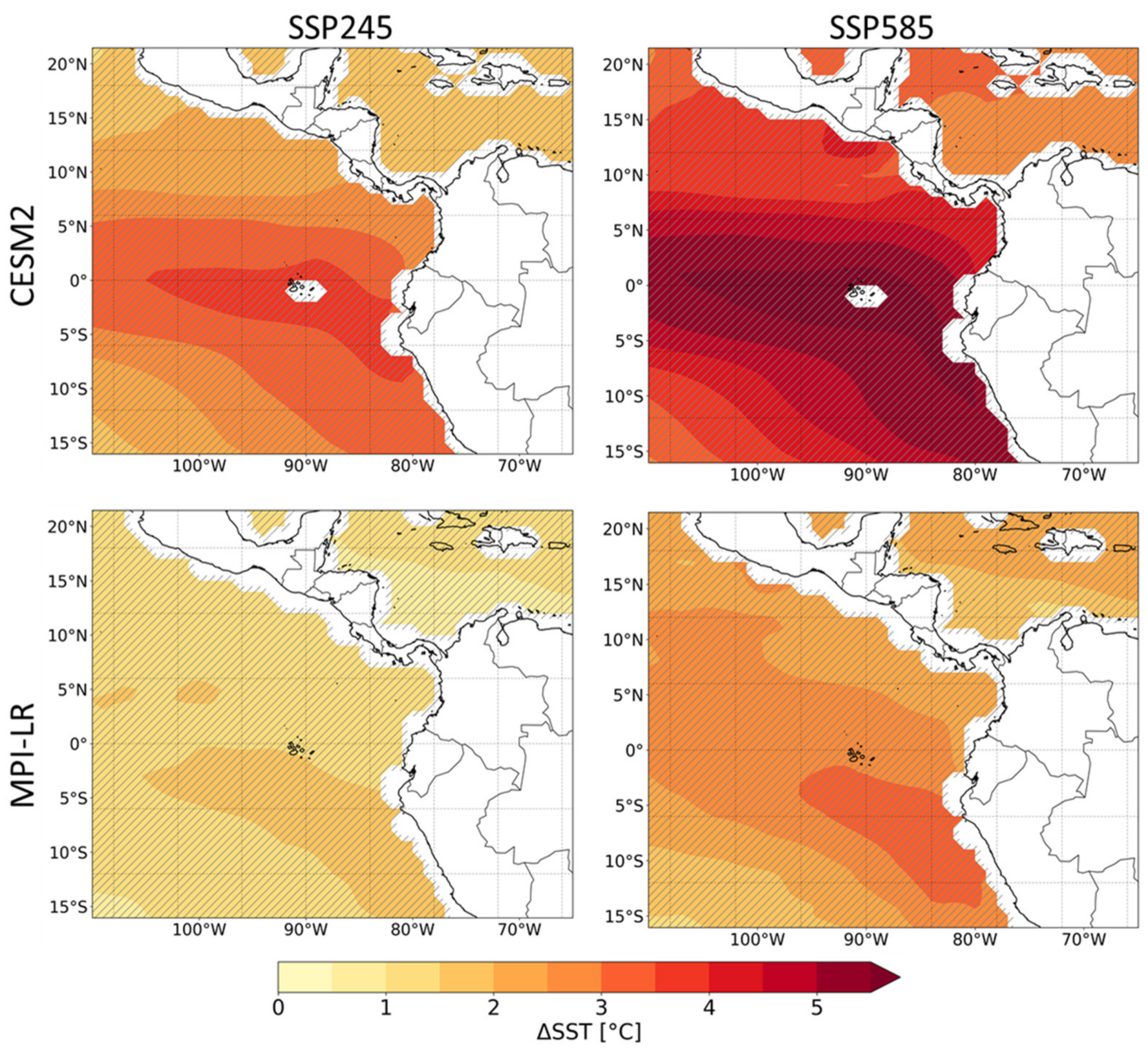
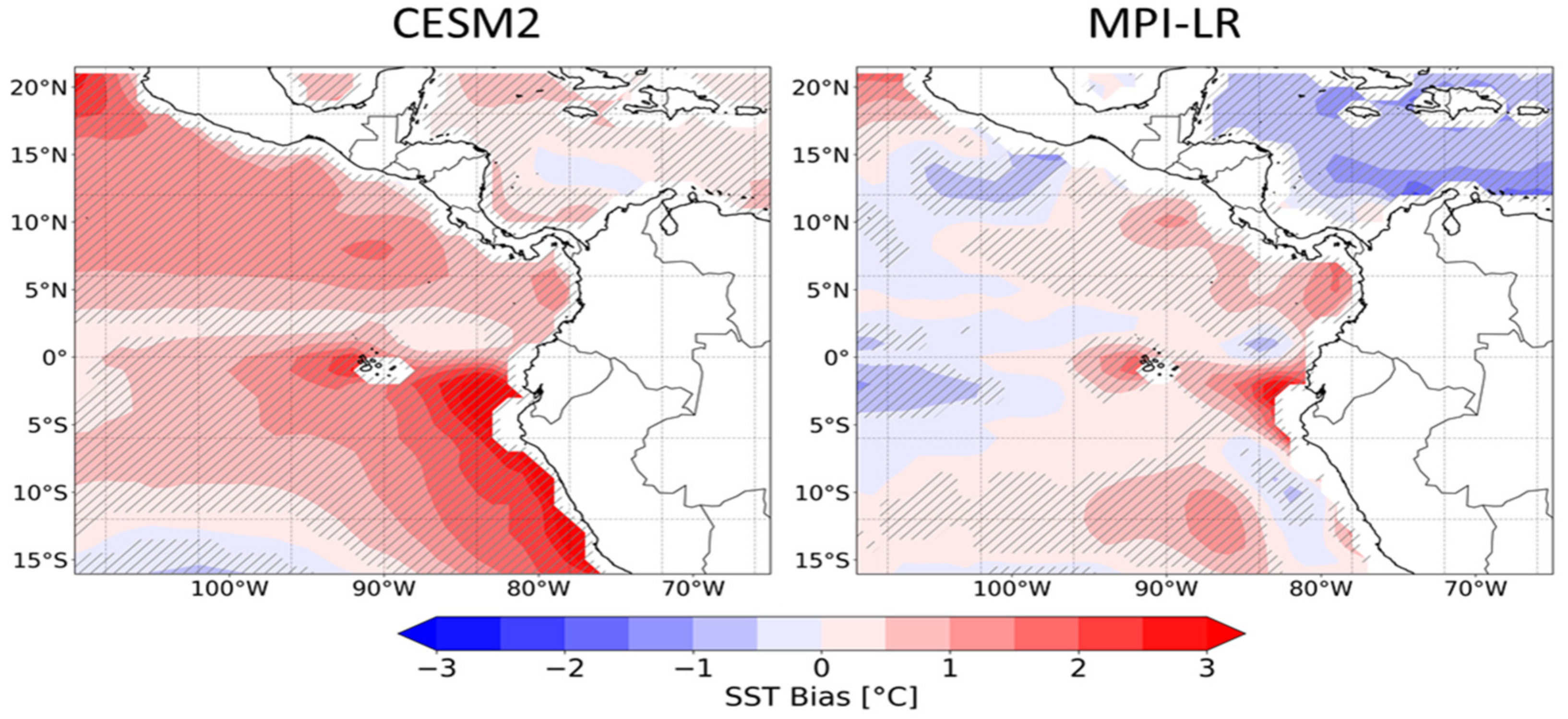
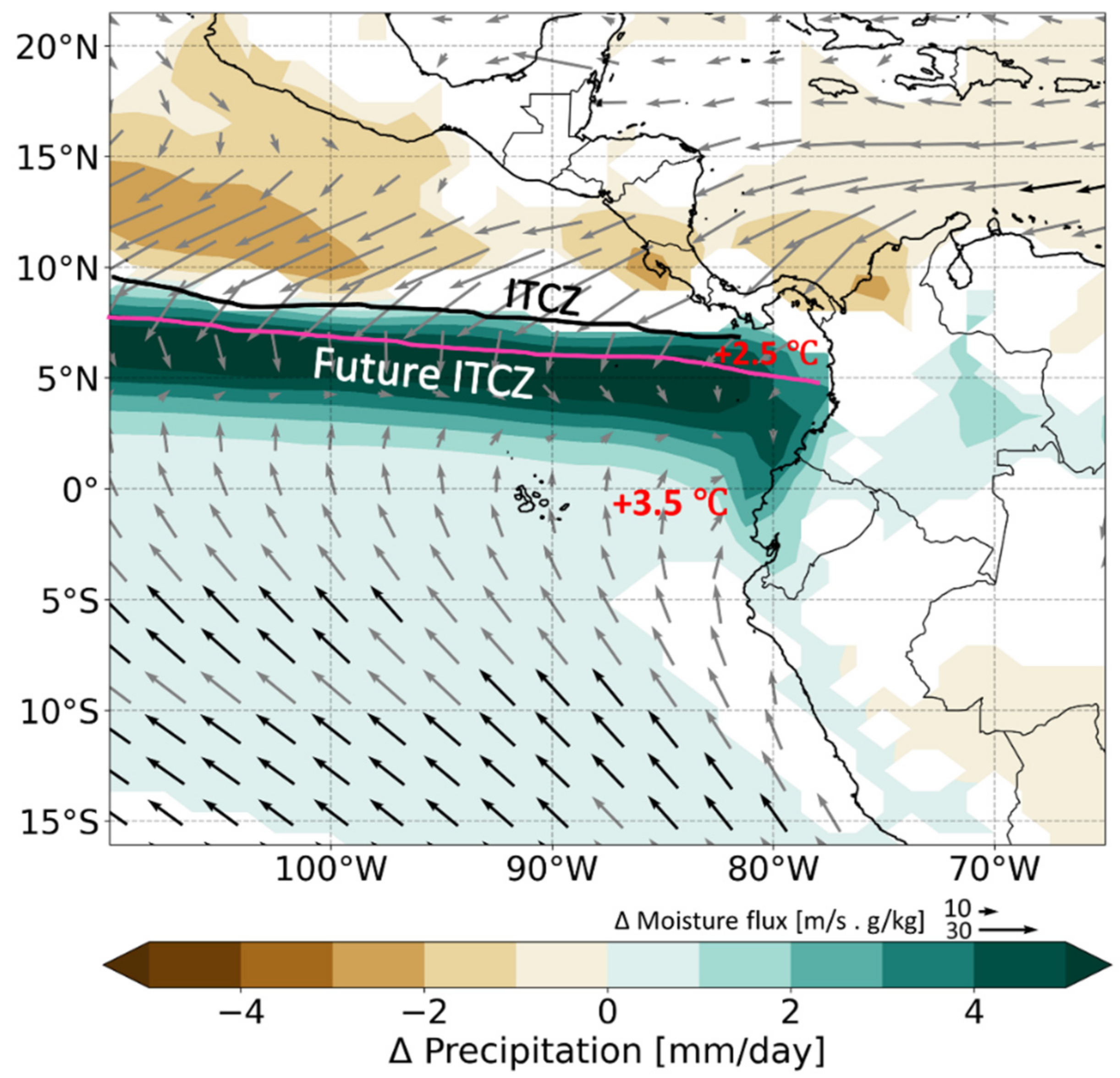
| Niño | Niña | |||
|---|---|---|---|---|
| Dataset | Frequency (Months) | Intensity (°C) | Frequency (Months) | Intensity (°C) |
| CESM2 Historical | 96 | 1.49 | 123 | −1.19 |
| CESM2 SSP245 | 98 | 1.33 | 112 | −1.10 |
| CESM2 SSP585 | 100 | 1.14 | 91 | −1.300 |
| MPI-LR Historical | 80 | 0.86 | 64 | −1.05 |
| MPI-LR SSP245 | 81 | 0.93 | 85 | −0.91 |
| MPI-LR SSP585 | 84 | 1.05 | 89 | −1.14 |
Publisher’s Note: MDPI stays neutral with regard to jurisdictional claims in published maps and institutional affiliations. |
© 2022 by the authors. Licensee MDPI, Basel, Switzerland. This article is an open access article distributed under the terms and conditions of the Creative Commons Attribution (CC BY) license (https://creativecommons.org/licenses/by/4.0/).
Share and Cite
Valencia, J.; Mejía, J.F. Projected Changes of Day-to-Day Precipitation and Choco Low-Level Jet Relationships over the Far Eastern Tropical Pacific and Western Colombia from Two CMIP6 GCM Models. Atmosphere 2022, 13, 1776. https://doi.org/10.3390/atmos13111776
Valencia J, Mejía JF. Projected Changes of Day-to-Day Precipitation and Choco Low-Level Jet Relationships over the Far Eastern Tropical Pacific and Western Colombia from Two CMIP6 GCM Models. Atmosphere. 2022; 13(11):1776. https://doi.org/10.3390/atmos13111776
Chicago/Turabian StyleValencia, Juliana, and John F. Mejía. 2022. "Projected Changes of Day-to-Day Precipitation and Choco Low-Level Jet Relationships over the Far Eastern Tropical Pacific and Western Colombia from Two CMIP6 GCM Models" Atmosphere 13, no. 11: 1776. https://doi.org/10.3390/atmos13111776
APA StyleValencia, J., & Mejía, J. F. (2022). Projected Changes of Day-to-Day Precipitation and Choco Low-Level Jet Relationships over the Far Eastern Tropical Pacific and Western Colombia from Two CMIP6 GCM Models. Atmosphere, 13(11), 1776. https://doi.org/10.3390/atmos13111776







